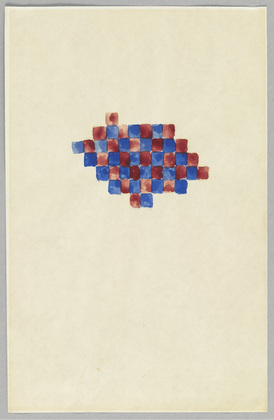juan gris checkerboard 1915
man rays end-game and other modernists gambits
knight fear: hippophobia
duchamp portrait of chess players 1911
villon chessboard 1920
Finally, Paul Klee's The Great Chess Game and Juan Gris's Chess Pieces iconographically evoke the theme of artistic resourcefulness through the image of chess. Klee's painting, rendered in the German Expressionist style, arranges the canvas into a kind of pattern or code of colored squares that take the form of a chessboard. This compositional system of squares recalls Kandinsky's notion of a codified language of abstraction, especially when we consider how the runic pieces are cryptographically evocative of hidden meaning. These pieces seem to spell out an abstract game position that makes no real sense in terms of actual chess, but plenty of sense in terms of artistic pattern and compositional arrangement.

Richard Tuttle
Checker Board Series (1)
1968. Watercolor on paper, 9 x 5 3/4"
orphism (kupka, delaunay, picabia) overlapping planes
While cross-sensory metaphors (e.g., "loud shirt," "bitter wind" or "prickly laugh") are sometimes described as "synesthetic," true neurological synesthesia is involuntary. It is estimated that synesthesia could possibly be as prevalent as 1 in 23 persons across its range of variants.[17] Synesthesia runs strongly in families, but the precise mode of inheritance has yet to be ascertained. Synesthesia is also sometimes reported by individuals under the influence of psychedelic drugs, after a stroke, during a temporal lobe epilepsy seizure, or as a result of blindness or deafness. Synesthesia that arises from such non-genetic events is referred to as "adventitious synesthesia" to distinguish it from the more common congenital forms of synesthesia. Adventitious synesthesia involving drugs or stroke (but not blindness or deafness) apparently only involves sensory linkings such as sound → vision or touch → hearing; there are few, if any, reported cases involving culture-based, learned sets such as graphemes, lexemes, days of the week, or months of the year.
Although synesthesia was the topic of intensive scientific investigation in the late 19th century and early 20th century, it was largely abandoned by scientific research in the mid-20th century, and has only recently been rediscovered by modern researchers.[18] Psychological research has demonstrated that synesthetic experiences can have measurable behavioral consequences, while functional neuroimaging studies have identified differences in patterns of brain activation.[6] Many people with synesthesia use their experiences to aid in their creative process, and many non-synesthetes have attempted to create works of art that may capture what it is like to experience synesthesia. Psychologists and neuroscientists study synesthesia not only for its inherent interest, but also for the insights it may give into cognitive and perceptual processes that occur in synesthetes and non-synesthetes alike.
|
- bill 1-30-2011 3:49 pm
man rays end-game and other modernists gambits
- bill 1-30-2011 9:17 pm [add a comment]
knight fear: hippophobia
- bill 1-30-2011 9:41 pm [add a comment]
duchamp portrait of chess players 1911
villon chessboard 1920
- bill 1-30-2011 9:49 pm [add a comment]
- bill 1-30-2011 10:18 pm [add a comment]
Richard Tuttle Checker Board Series (1) 1968. Watercolor on paper, 9 x 5 3/4"
- bill 1-30-2011 10:30 pm [add a comment]
orphism (kupka, delaunay, picabia) overlapping planes
- bill 1-30-2011 10:54 pm [add a comment]
- bill 1-30-2011 11:06 pm [add a comment]